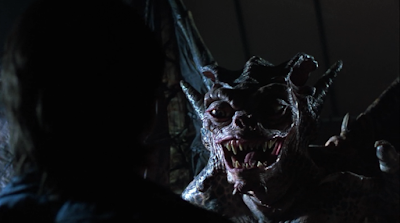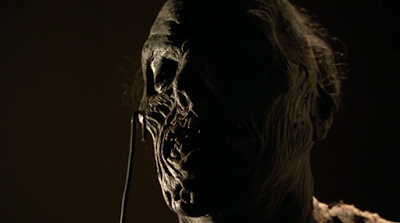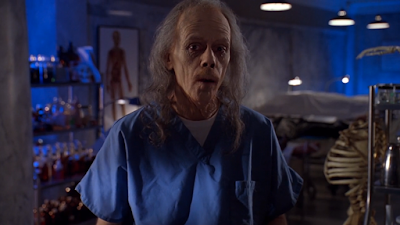I'm not "officially" doing The October Horror Movie Challenge this year. I'm not aiming to watch all the films and I'm definitely not going to break my back to blog about it all, but it's still October, and October still means horror movies here at Stately Krell Laboratories. Therefore...
I originally saw Tales from the Darkside: The Movie (1990, directed by John Harrison) in theaters and then never thought of it again. Subsequently, I had forgotten almost all of it. I had forgotten that there was a framing story, in which Debbie Harry plays a suburban witch whose "meat" for her dinner party--in fact a small boy--Scheherezades her with stories from the eponymous book. I had forgotten that the first story, an adaptation of Arthur Conan Doyle's "Lot 249," stars young Julianne Moore and young Steve Buscemi and already on a career downswing Christian Slater. I had forgotten that the second story was written by Stephen King and that it's not one of his finer efforts. I had forgotten that David Johansen played a hit-man in the lead in the second story, and that the film itself chooses not to include any music from him. I DID remember that the third story is a version of "The Woman of the Snows," the Japanese ghost story that memorably kicks off Masaki Kobayashi's Kwaidan. I might as well never have seen the film at all for all the impression it made on me.
The first segment, a mummy story cross-pollinated by EC Comics, in which horrible people get their comeuppance, is the most gleefully entertaining, but that doesn't necessarily make it the best part of the film. It's fun watching Julianne Moore in full-on bitch mode as a woman who helped her boyfriend swipe a fellowship from creepy archaeologist Steve Buscemi. Christian Slater works okay as the audience's point of view, a classic "nice guy" who turns out to have a fatal flaw of his own. This is an agreeably mean story, in which the guy who would be the villain in most horror stories actually gets his revenge. The mummy in this story is pretty good, and its means of dispatching his victims--by reenacting the process of mummification on living people--is delightfully gruesome.
The second segment, King's "The Cat From Hell," finds hitman Johansen hired by retired pharmaceutical tycoon/racketeer William Hickey to do in the family cat. The cat, Hickey's character says, has done in the rest of his family. This is a riff on Poe's "The Black Cat," and it's pretty silly. It's filmed in a 1980s direct to video noir idiom with flashbacks utilizing a bunch of distorting lenses, which lend it a hothouse ambiance, but this segment is poorly conceived.
The third segment, as I've said, is a version of "Woman of the Snows," in which a man (James Remar) witnesses a grotesque murder. He's spared by the creature who commits the murder only after vowing never to disclose what he's seen. He returns to his life and meets a woman with whom he falls in love and starts a family (Rae Dawn Chong). Ten years after the murders, he finally feels safe enough to disclose what he saw to his wife, with tragic consequences. This was the segment that I carried away with me after I first saw the film, and in revisiting it 25 years later, it's easy to see why it stands up. It's got a better story than either of the first two segments, one that's romantic and tragic rather than one that's contingent on a twist at the end. Oh, it has a twist, but the twist is the kind of thing one finds in a fairy tale rather than a conte cruel. In its formal considerations, it's not much different than the rest of the film. Writing will out. It does have a pretty spiffy monster, though. It's an elaborate animatronic puppet that is perhaps not a sophisticated as the ones in Little Shop of Horrors or Gremlins 2, but its a lovingly-made thing at the twilight of practical effects.
I found the framing sequence to be the most engaging thing in the film this time around. I had forgotten Debbie Harry's chirpy witch character, and the little kid is snotty enough that one hopes to watch him roast. Of course, that doesn't happen. The kid escapes and gives a wink at the audience, which is unearned. That's okay. There's enough fun involved to forgive the film for how it ends. One other thing I take away from this film is a profound sense of sadness, given that screenwriter Michael McDowell was an AIDS casualty soon afterward. McDowell wrote a couple of films, but I remember him best as the author of profoundly unpleasant paperback original novels like Cold Moon Over Babylon and The Amulet, which have a place in my affections.
Even though John Carpenter's Body Bags (1993), has a headier pedigree--where Tales from the Darkside's director, John Harrison, came from the TV show and returned to TV afterward, the segments of Body Bags are directed by Carpenter himself and Tobe Hooper--in some ways, it has the same drawbacks. This is a film that's also influenced by EC Comics, it's also a film in which its ambitions outstrip its resources, and Debbie Harry is on hand again. Not that Debbie Harry is a liability, mind you. It's just fun that she's in both of these movies.
The framing sequence in Body Bags finds a ghoulish coroner played by Carpenter himself piecing together the stories of how the various cadavers in his care were done-in. Carpenter totally plays him as a version of the Crypt Keeper, complete with macabre bon mots. In a lot of ways, the framing sequence is what gives the film its personality, because the three mainline segments are typical anthology short stories. What sets them apart, especially when set against Tales from the Darkside, is that this has the services of major directors. Film, after all, is a director's medium.
The first segment finds a woman arriving for her first overnight of work at a remote gas station. The radio informs her that there's an escaped serial killer out there somewhere, so her every interaction with customers from inside her glass booth is loaded with menace. As it turns out, the psycho does show up and lays siege to the cashier's booth as our heroine scrambles to stay alive. This gets the movie started with bang. Carpenter directs this with all the merciless tension of his best films, where each shot counts and there's no fat to trim. It's a compact little masterpiece, and Carpenter's best filmmaking of the 1990s.
The second segment finds a middle aged business man trying to preserve his sex appeal by a engaging a radical hair restoration cure. His vanity is an annoyance to his girlfriend, but he forges ahead anyway, and soon enters the care of one "Dr. Lock," who operates on his scalp. Lock's cure is as good as advertised, and the man soon has a mane of flowing tresses. Unfortunately, the treatment has side-effects, and he soon feels sick and fatigued. Worse, soon, the hair is growing everywhere. When he returns to Dr. Lock, he discovers the horrifying truth about his new hair. This segment is a lark, both a satire of male vanity and a funny shaggy dog story. The sight of Stacey Keach sporting a Conan the Barbarian hairdo is one of the funniest things Carpenter has ever filmed. If the payoff isn't worthy of the build-up, well, the build-up is pretty good.
The third segment is directed by Tobe Hooper rather than Carpenter, and it follows the travails of a baseball player who loses an eye--and hence his ability to play ball--in a car accident. Fortunately, he's in luck: there's an experimental surgical procedure that can transplant an eye for the one he lost. Unfortunately, the eye sees things differently than what other people see. Worse, our hero begins to have nightmares about killing and raping women. The eye, it seems, came from a recently-executed murderer and necrophile. The spirit of the man was carried with his eye to a new host. When he wakes up near the scene of another murder, he confesses his suspicions to his wife. Unfortunately, the spirit of the dead killer attempts to kill his wife, and radical measures must be taken. This segment is the most brutal part of the movie--in keeping with Hooper's more visceral approach to horror rather than Carpenter's elegant suspense. This is a story with its foot in the past and the present, too. It's in the tradition of The Hands of Orlock and its obsession with eye injuries is worthy of Lucio Fulci, but it also looks forward to films like The Eye from the Asian horror boom later in the decade.
Body Bags is one of Carpenter's most self aware movies. Never shy about including in-jokes for horror and other movie fans, those jokes are right up front in this. The various supporting characters in the first segment are played by the likes of David Naughton, Sam Raimi, and the late Wes Craven (Craven's passing, I should note, is the reason I revisited this film). Certainly, casting himself as the host is Carpenter stepping into the shoes of Alfred Hitchcock and signing his work with a flourish, though his character here is more macabre than any persona Hitchcock ever adopted. Sometimes, the film's self-awareness is too on point, but for the most part, it's fun. It might be Carpenter's best film of the 1990s, though that's faint praise in the face of Carpenter's late career.

I'm using Patreon as a means of funding my blogs. They don't have a widget yet, so this link will just have to do. If you like my writing and art and if you'd like to support Krell Laboratories and Christianne's Art and Comics, please come on over and pledge. Thanks.




















No comments:
Post a Comment